fuse FORD TAURUS 2018 Owners Manual
[x] Cancel search | Manufacturer: FORD, Model Year: 2018, Model line: TAURUS, Model: FORD TAURUS 2018Pages: 510, PDF Size: 22.04 MB
Page 7 of 510

Roadside Emergencies
Roadside Assistance
..................................213
Hazard Flashers ............................................
214
Fuel Shutoff ...................................................
214
Jump Starting the Vehicle ........................
215
Post-Crash Alert System ...........................
217
Transporting the Vehicle ...........................
217
Customer Assistance
Getting the Services You Need ...............
219
In California (U.S. Only) ...........................
220
The Better Business Bureau (BBB) Auto Line Program (U.S. Only) ......................
221
Utilizing the Mediation/Arbitration Program (Canada Only) .......................
222
Getting Assistance Outside the U.S. and Canada .......................................................
222
Ordering Additional Owner's Literature ........................................................................\
223
Reporting Safety Defects (U.S. Only) ........................................................................\
224
Reporting Safety Defects (Canada Only) ........................................................................\
224
Fuses
Fuse Specification Chart .........................
226
Changing a Fuse ..........................................
235
Maintenance
General Information ...................................
237
Opening and Closing the Hood ..............
237
Under Hood Overview - 2.0L EcoBoost™ ........................................................................\
238
Under Hood Overview - 3.5L Duratec ........................................................................\
239
Under Hood Overview - 3.5L Ecoboost™ ........................................................................\
.
241
Engine Oil Dipstick - 2.0L EcoBoost™ ........................................................................\
242
Engine Oil Dipstick - 3.5L Duratec/3.5L Ecoboost™ ...............................................
242
Engine Oil Check .........................................
242Oil Change Indicator Reset
.....................
243
Engine Coolant Check ..............................
244
Automatic Transmission Fluid Check - 2.0L EcoBoost™ .....................................
248
Automatic Transmission Fluid Check - 3.5L Duratec/3.5L Ecoboost™ .........
248
Brake Fluid Check ........................................
251
Power Steering Fluid Check ....................
252
Washer Fluid Check ...................................
252
Fuel Filter .......................................................
252
Changing the 12V Battery ........................
252
Checking the Wiper Blades .....................
254
Changing the Wiper Blades ....................
255
Adjusting the Headlamps ........................
255
Changing a Bulb ..........................................
256
Bulb Specification Chart ..........................
257
Changing the Engine Air Filter ...............
259
Vehicle Care
General Information ..................................
260
Cleaning Products .....................................
260
Cleaning the Exterior ................................
260
Waxing .............................................................
261
Cleaning the Engine ...................................
262
Cleaning the Windows and Wiper Blades ........................................................................\
262
Cleaning the Interior ..................................
263
Cleaning the Instrument Panel and Instrument Cluster Lens ......................
263
Cleaning Leather Seats ............................
264
Repairing Minor Paint Damage .............
264
Cleaning the Wheels .................................
264
Vehicle Storage ...........................................
265
Wheels and Tires
General Information ..................................
267
Tire Sealant and Inflator Kit ....................
267
Tire Care ..........................................................
273
Using Summer Tires ..................................
286
Using Snow Chains ....................................
286
4
Taurus (CPH) Canada/United States of America, enUSA, Edition date: 201709, Second Printing Table of Contents
Page 11 of 510
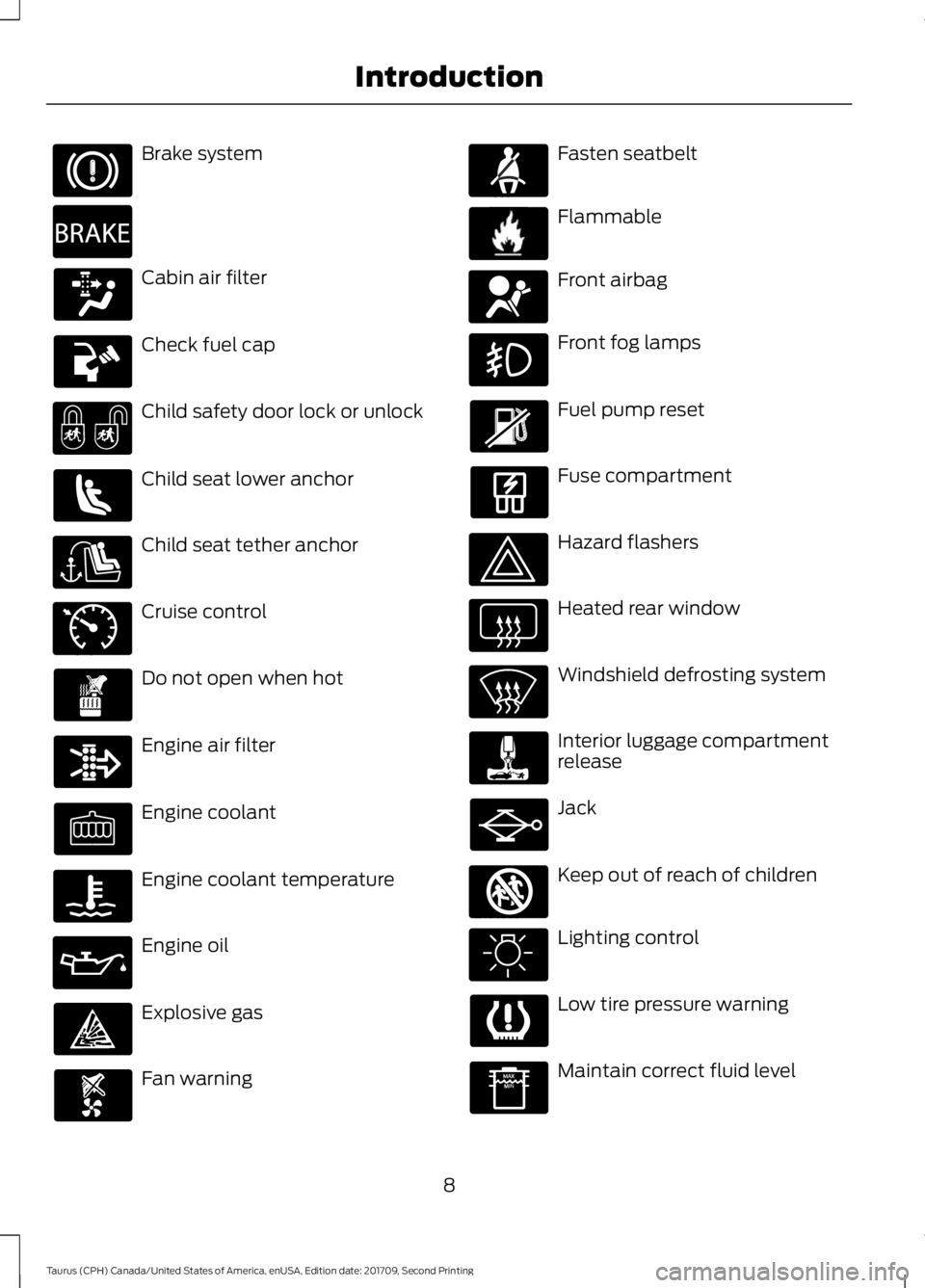
Brake system
Cabin air filter
Check fuel cap
Child safety door lock or unlock
Child seat lower anchor
Child seat tether anchor
Cruise control
Do not open when hot
Engine air filter
Engine coolant
Engine coolant temperature
Engine oil
Explosive gas
Fan warning Fasten seatbelt
Flammable
Front airbag
Front fog lamps
Fuel pump reset
Fuse compartment
Hazard flashers
Heated rear window
Windshield defrosting system
Interior luggage compartment
release
Jack
Keep out of reach of children
Lighting control
Low tire pressure warning
Maintain correct fluid level
8
Taurus (CPH) Canada/United States of America, enUSA, Edition date: 201709, Second Printing Introduction E270480 E71340 E71880 E231160 E67017 E161353
Page 45 of 510
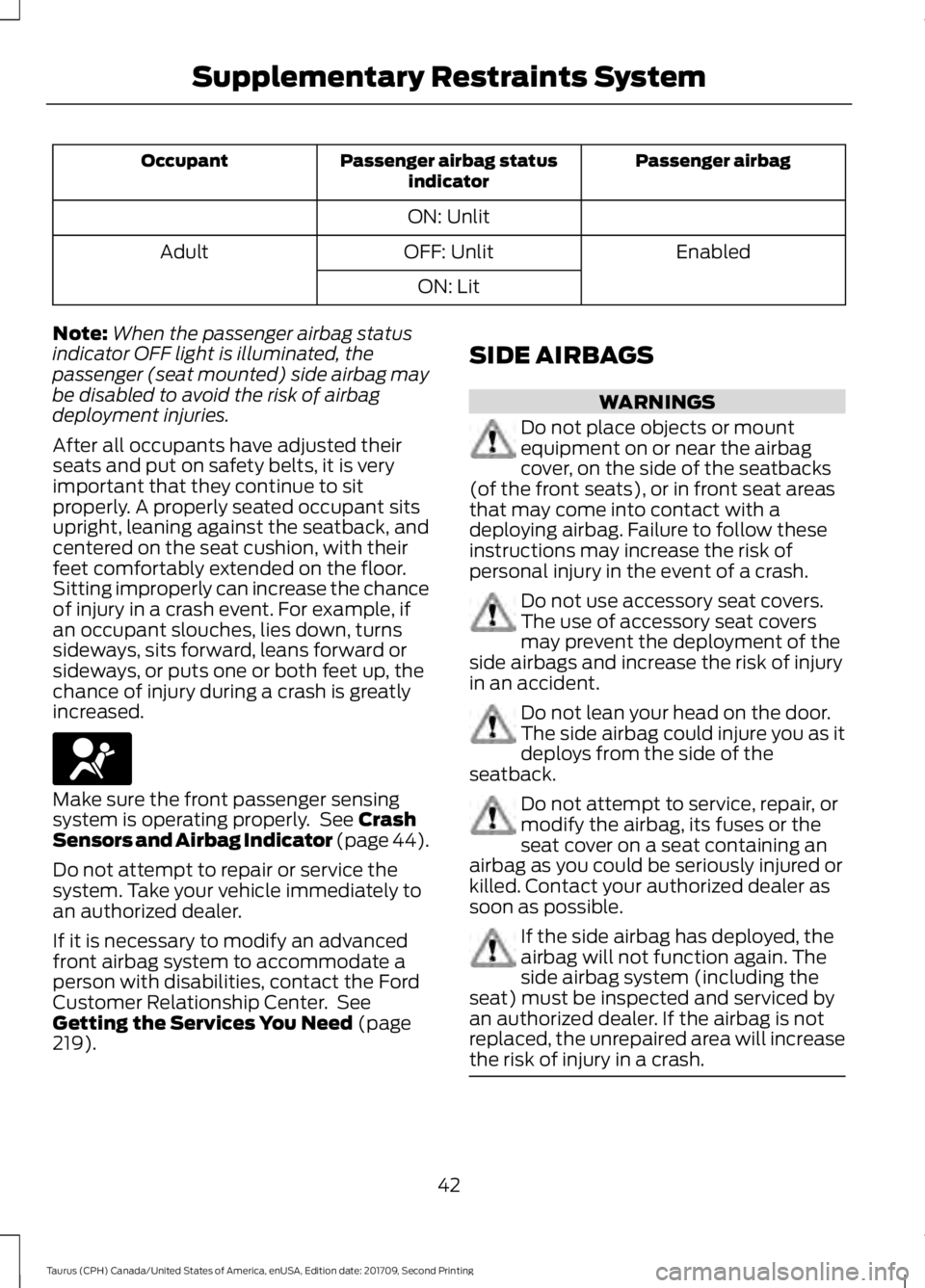
Passenger airbag
Passenger airbag status
indicator
Occupant
ON: Unlit Enabled
OFF: Unlit
Adult
ON: Lit
Note: When the passenger airbag status
indicator OFF light is illuminated, the
passenger (seat mounted) side airbag may
be disabled to avoid the risk of airbag
deployment injuries.
After all occupants have adjusted their
seats and put on safety belts, it is very
important that they continue to sit
properly. A properly seated occupant sits
upright, leaning against the seatback, and
centered on the seat cushion, with their
feet comfortably extended on the floor.
Sitting improperly can increase the chance
of injury in a crash event. For example, if
an occupant slouches, lies down, turns
sideways, sits forward, leans forward or
sideways, or puts one or both feet up, the
chance of injury during a crash is greatly
increased. Make sure the front passenger sensing
system is operating properly. See Crash
Sensors and Airbag Indicator (page 44).
Do not attempt to repair or service the
system. Take your vehicle immediately to
an authorized dealer.
If it is necessary to modify an advanced
front airbag system to accommodate a
person with disabilities, contact the Ford
Customer Relationship Center. See
Getting the Services You Need
(page
219). SIDE AIRBAGS WARNINGS
Do not place objects or mount
equipment on or near the airbag
cover, on the side of the seatbacks
(of the front seats), or in front seat areas
that may come into contact with a
deploying airbag. Failure to follow these
instructions may increase the risk of
personal injury in the event of a crash. Do not use accessory seat covers.
The use of accessory seat covers
may prevent the deployment of the
side airbags and increase the risk of injury
in an accident. Do not lean your head on the door.
The side airbag could injure you as it
deploys from the side of the
seatback. Do not attempt to service, repair, or
modify the airbag, its fuses or the
seat cover on a seat containing an
airbag as you could be seriously injured or
killed. Contact your authorized dealer as
soon as possible. If the side airbag has deployed, the
airbag will not function again. The
side airbag system (including the
seat) must be inspected and serviced by
an authorized dealer. If the airbag is not
replaced, the unrepaired area will increase
the risk of injury in a crash. 42
Taurus (CPH) Canada/United States of America, enUSA, Edition date: 201709, Second Printing Supplementary Restraints SystemE67017
Page 136 of 510
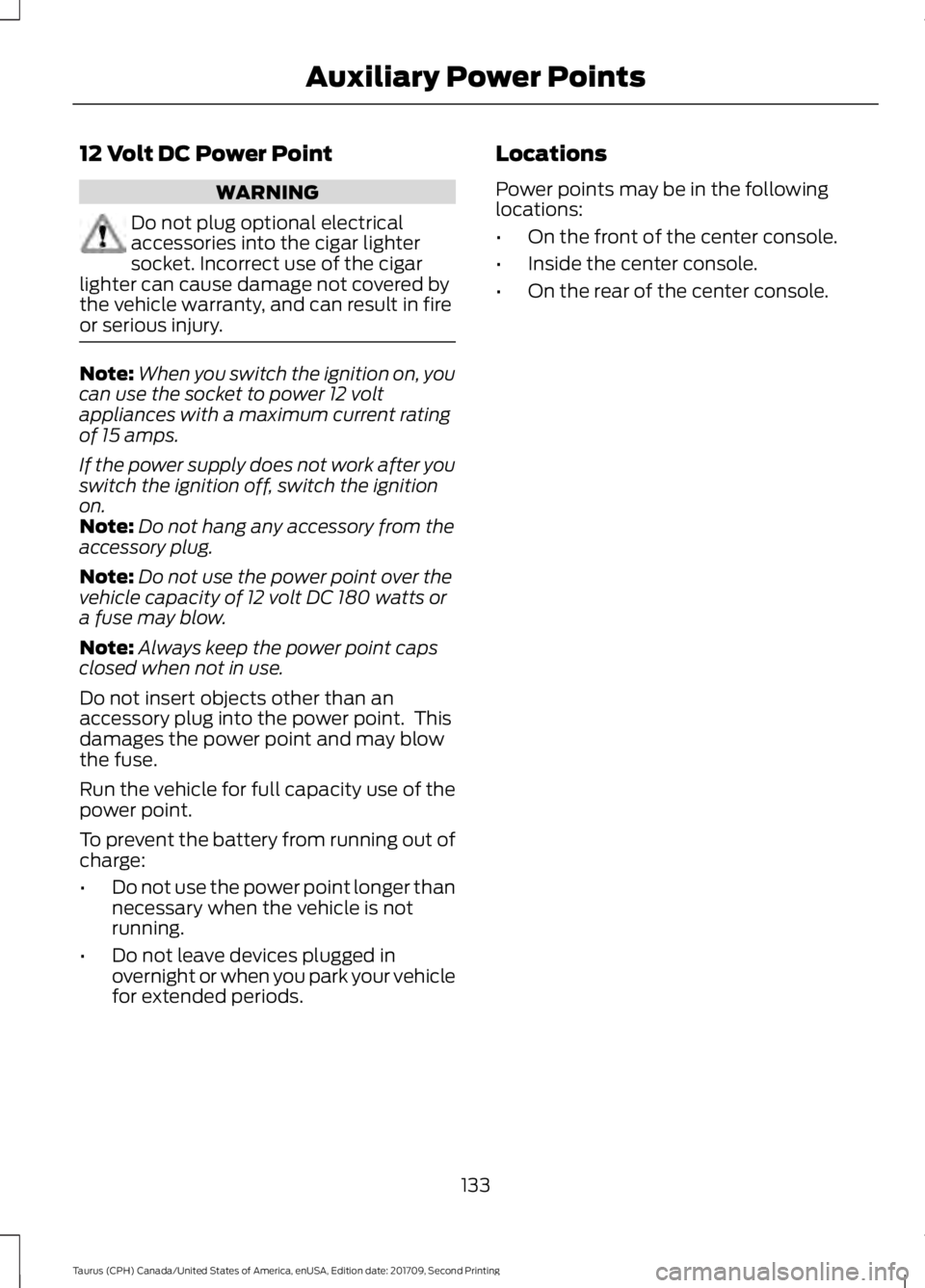
12 Volt DC Power Point
WARNING
Do not plug optional electrical
accessories into the cigar lighter
socket. Incorrect use of the cigar
lighter can cause damage not covered by
the vehicle warranty, and can result in fire
or serious injury. Note:
When you switch the ignition on, you
can use the socket to power 12 volt
appliances with a maximum current rating
of 15 amps.
If the power supply does not work after you
switch the ignition off, switch the ignition
on.
Note: Do not hang any accessory from the
accessory plug.
Note: Do not use the power point over the
vehicle capacity of 12 volt DC 180 watts or
a fuse may blow.
Note: Always keep the power point caps
closed when not in use.
Do not insert objects other than an
accessory plug into the power point. This
damages the power point and may blow
the fuse.
Run the vehicle for full capacity use of the
power point.
To prevent the battery from running out of
charge:
• Do not use the power point longer than
necessary when the vehicle is not
running.
• Do not leave devices plugged in
overnight or when you park your vehicle
for extended periods. Locations
Power points may be in the following
locations:
•
On the front of the center console.
• Inside the center console.
• On the rear of the center console.
133
Taurus (CPH) Canada/United States of America, enUSA, Edition date: 201709, Second Printing Auxiliary Power Points
Page 146 of 510
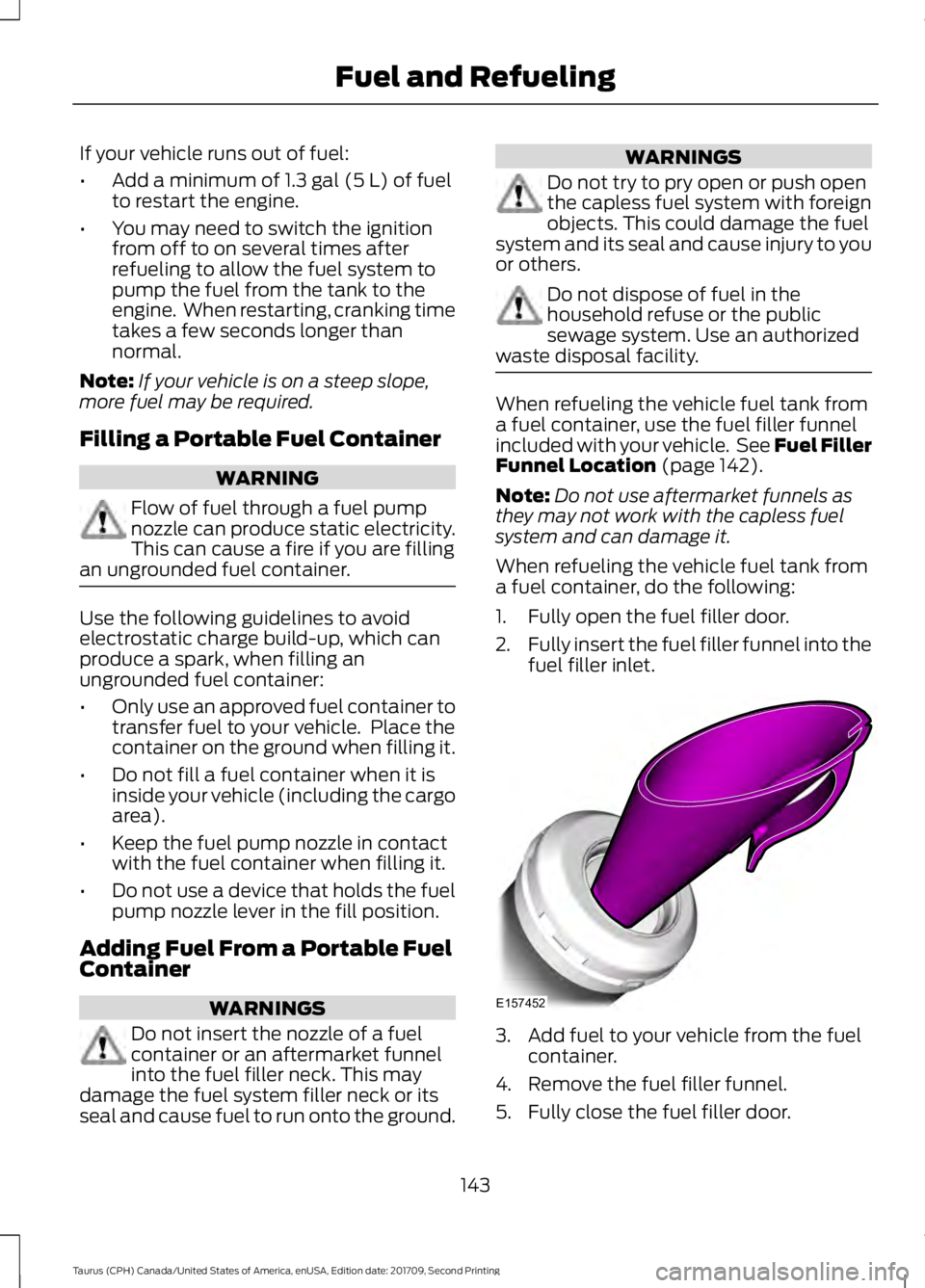
If your vehicle runs out of fuel:
•
Add a minimum of 1.3 gal (5 L) of fuel
to restart the engine.
• You may need to switch the ignition
from off to on several times after
refueling to allow the fuel system to
pump the fuel from the tank to the
engine. When restarting, cranking time
takes a few seconds longer than
normal.
Note: If your vehicle is on a steep slope,
more fuel may be required.
Filling a Portable Fuel Container WARNING
Flow of fuel through a fuel pump
nozzle can produce static electricity.
This can cause a fire if you are filling
an ungrounded fuel container. Use the following guidelines to avoid
electrostatic charge build-up, which can
produce a spark, when filling an
ungrounded fuel container:
•
Only use an approved fuel container to
transfer fuel to your vehicle. Place the
container on the ground when filling it.
• Do not fill a fuel container when it is
inside your vehicle (including the cargo
area).
• Keep the fuel pump nozzle in contact
with the fuel container when filling it.
• Do not use a device that holds the fuel
pump nozzle lever in the fill position.
Adding Fuel From a Portable Fuel
Container WARNINGS
Do not insert the nozzle of a fuel
container or an aftermarket funnel
into the fuel filler neck. This may
damage the fuel system filler neck or its
seal and cause fuel to run onto the ground. WARNINGS
Do not try to pry open or push open
the capless fuel system with foreign
objects. This could damage the fuel
system and its seal and cause injury to you
or others. Do not dispose of fuel in the
household refuse or the public
sewage system. Use an authorized
waste disposal facility. When refueling the vehicle fuel tank from
a fuel container, use the fuel filler funnel
included with your vehicle. See Fuel Filler
Funnel Location
(page 142).
Note: Do not use aftermarket funnels as
they may not work with the capless fuel
system and can damage it.
When refueling the vehicle fuel tank from
a fuel container, do the following:
1. Fully open the fuel filler door.
2. Fully insert the fuel filler funnel into the
fuel filler inlet. 3. Add fuel to your vehicle from the fuel
container.
4. Remove the fuel filler funnel.
5. Fully close the fuel filler door.
143
Taurus (CPH) Canada/United States of America, enUSA, Edition date: 201709, Second Printing Fuel and RefuelingE157452
Page 208 of 510

TOWING A TRAILER
WARNINGS
Towing trailers beyond the
maximum recommended
gross trailer weight exceeds the
limit of your vehicle and could
result in engine damage,
transmission damage, structural
damage, loss of vehicle control,
vehicle rollover and personal
injury. Do not exceed the GVWR or
the GAWR specified on the
certification label. Note:
See Recommended
Towing Weights (page 206).
Your vehicle may have electrical
items, such as fuses or relays,
related to towing. See
Fuses
(page 226).
Your vehicle's load capacity
designation is by weight, not by
volume, so you cannot necessarily
use all available space when
loading a vehicle or trailer.
Towing a trailer places an extra
load on your vehicle's engine,
transmission, axle, brakes, tires
and suspension. Inspect these
components periodically during,
and after, any towing operation. Load Placement
To help minimize how trailer
movement affects your vehicle
when driving:
•
Load the heaviest items closest
to the trailer floor.
• Load the heaviest items
centered between the left and
right side trailer tires.
• Load the heaviest items above
the trailer axles or just slightly
forward toward the trailer
tongue. Do not allow the final
trailer tongue weight to go
above or below 10-15% of the
loaded trailer weight.
• Select a ball mount with the
correct rise or drop and load
capacity. When both the
loaded vehicle and trailer are
connected, the trailer frame
should be level, or slightly
angled down toward your
vehicle, when viewed from the
side.
When driving with a trailer or
payload, a slight takeoff vibration
or shudder may be present due to
the increased payload weight.
Additional information regarding
proper trailer loading and setting
your vehicle up for towing is
located in another chapter of this
manual. See
Load Limit (page
200).
You can also find information in
the
RV & Trailer Towing Guide
available at your authorized
dealer, or online.
205
Taurus (CPH) Canada/United States of America, enUSA, Edition date: 201709, Second Printing Towing
Page 219 of 510
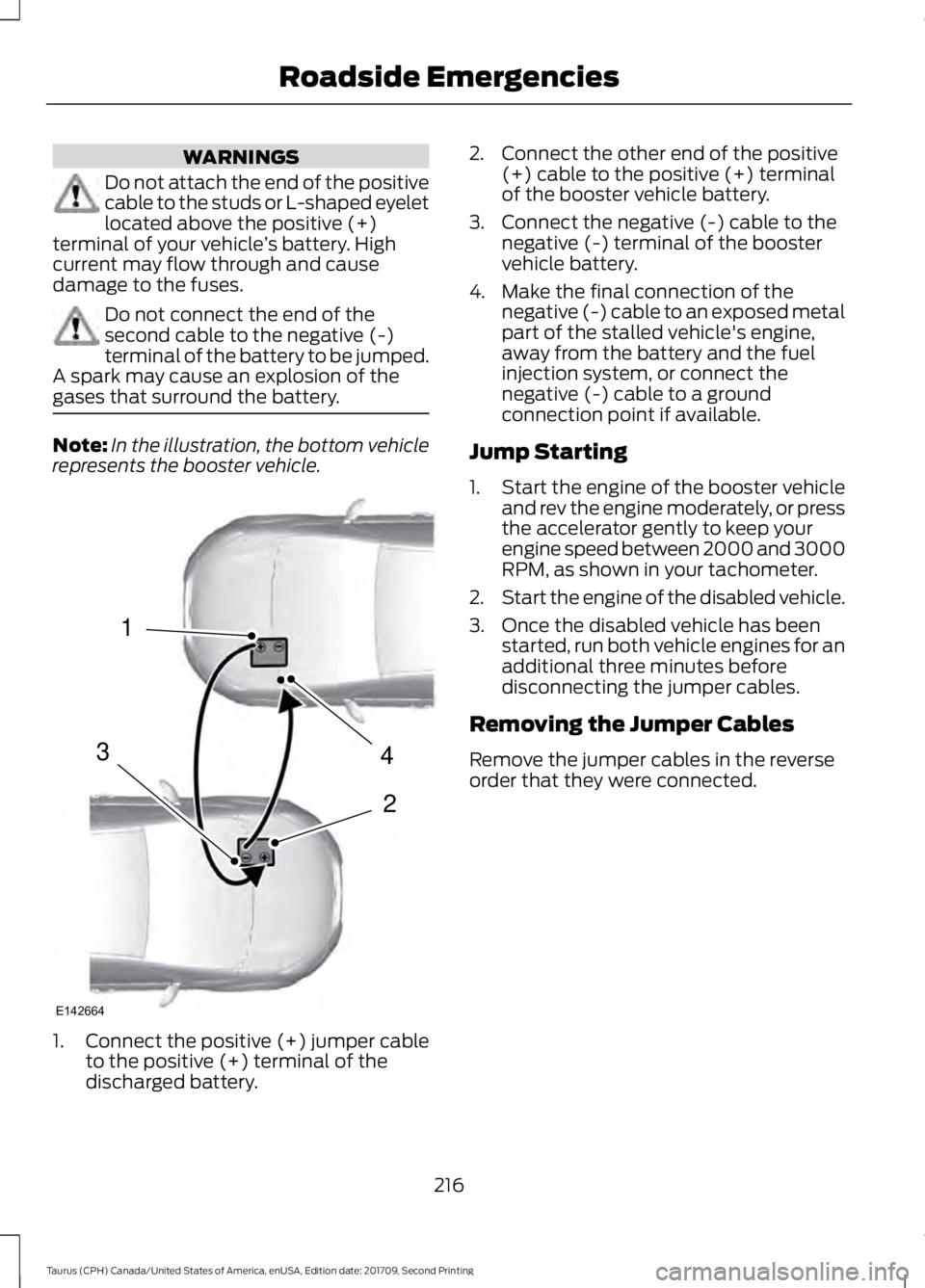
WARNINGS
Do not attach the end of the positive
cable to the studs or L-shaped eyelet
located above the positive (+)
terminal of your vehicle ’s battery. High
current may flow through and cause
damage to the fuses. Do not connect the end of the
second cable to the negative (-)
terminal of the battery to be jumped.
A spark may cause an explosion of the
gases that surround the battery. Note:
In the illustration, the bottom vehicle
represents the booster vehicle. 1.
Connect the positive (+) jumper cable
to the positive (+) terminal of the
discharged battery. 2. Connect the other end of the positive
(+) cable to the positive (+) terminal
of the booster vehicle battery.
3. Connect the negative (-) cable to the negative (-) terminal of the booster
vehicle battery.
4. Make the final connection of the negative (-) cable to an exposed metal
part of the stalled vehicle's engine,
away from the battery and the fuel
injection system, or connect the
negative (-) cable to a ground
connection point if available.
Jump Starting
1. Start the engine of the booster vehicle
and rev the engine moderately, or press
the accelerator gently to keep your
engine speed between 2000 and 3000
RPM, as shown in your tachometer.
2. Start the engine of the disabled vehicle.
3. Once the disabled vehicle has been started, run both vehicle engines for an
additional three minutes before
disconnecting the jumper cables.
Removing the Jumper Cables
Remove the jumper cables in the reverse
order that they were connected.
216
Taurus (CPH) Canada/United States of America, enUSA, Edition date: 201709, Second Printing Roadside Emergencies4
2
1
3
E142664
Page 229 of 510
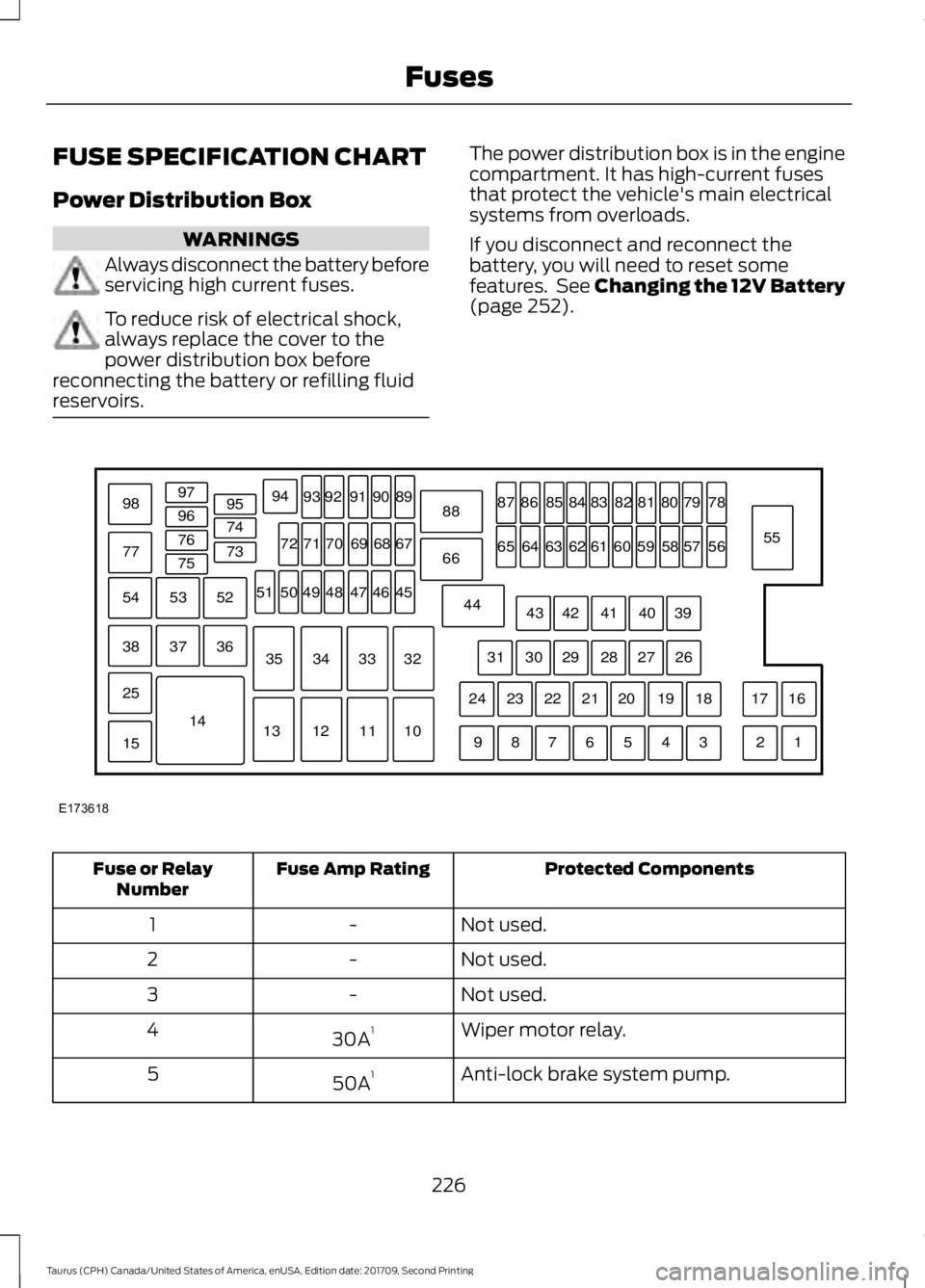
FUSE SPECIFICATION CHART
Power Distribution Box
WARNINGS
Always disconnect the battery before
servicing high current fuses.
To reduce risk of electrical shock,
always replace the cover to the
power distribution box before
reconnecting the battery or refilling fluid
reservoirs. The power distribution box is in the engine
compartment. It has high-current fuses
that protect the vehicle's main electrical
systems from overloads.
If you disconnect and reconnect the
battery, you will need to reset some
features. See Changing the 12V Battery
(page 252).
Protected Components
Fuse Amp Rating
Fuse or Relay
Number
Not used.
-
1
Not used.
-
2
Not used.
-
3
Wiper motor relay.
30A 1
4
Anti-lock brake system pump.
50A 1
5
226
Taurus (CPH) Canada/United States of America, enUSA, Edition date: 201709, Second Printing FusesE173618
97
98
77 96
95
94
9392 919089
88
66
44 78
56
39 26 18 16
17
3 1
2
4
5
6
7
8
9 19
20
21
22
23
24 27
28
29
30
31 40
41
42
43 55
57
58
59
60
61
62
63
64
65 79
80
81
82
83
84
85
86
87
67
45
32
10
11
12
13 33
34
35 46
47
48
49
50
51 68
69
70
71
72
74
73
76
75
53
37 36
54
38
25
15
1452
Page 230 of 510
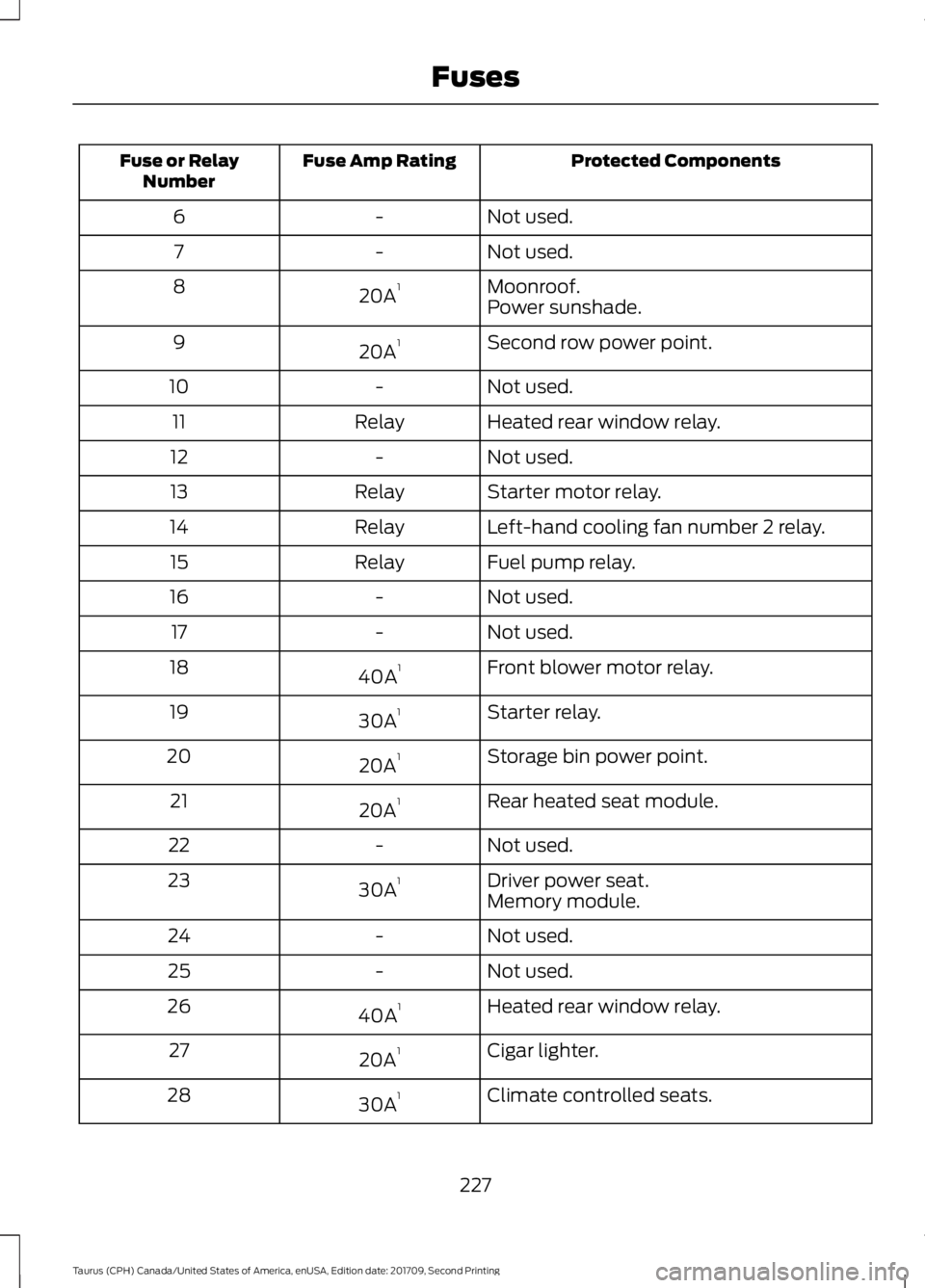
Protected Components
Fuse Amp Rating
Fuse or Relay
Number
Not used.
-
6
Not used.
-
7
Moonroof.
20A 1
8
Power sunshade.
Second row power point.
20A 1
9
Not used.
-
10
Heated rear window relay.
Relay
11
Not used.
-
12
Starter motor relay.
Relay
13
Left-hand cooling fan number 2 relay.
Relay
14
Fuel pump relay.
Relay
15
Not used.
-
16
Not used.
-
17
Front blower motor relay.
40A 1
18
Starter relay.
30A 1
19
Storage bin power point.
20A 1
20
Rear heated seat module.
20A 1
21
Not used.
-
22
Driver power seat.
30A 1
23
Memory module.
Not used.
-
24
Not used.
-
25
Heated rear window relay.
40A 1
26
Cigar lighter.
20A 1
27
Climate controlled seats.
30A 1
28
227
Taurus (CPH) Canada/United States of America, enUSA, Edition date: 201709, Second Printing Fuses
Page 231 of 510
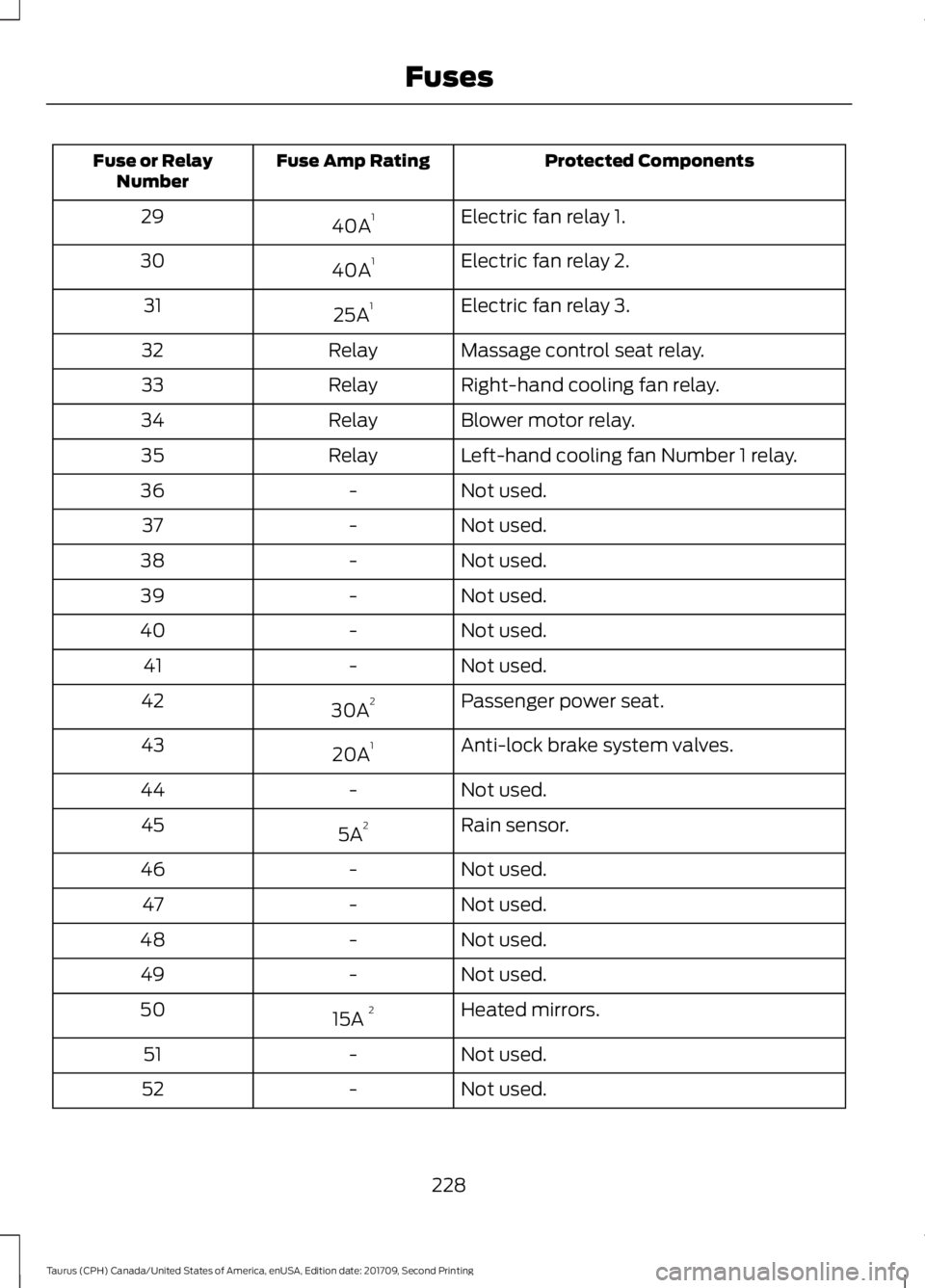
Protected Components
Fuse Amp Rating
Fuse or Relay
Number
Electric fan relay 1.
40A 1
29
Electric fan relay 2.
40A 1
30
Electric fan relay 3.
25A 1
31
Massage control seat relay.
Relay
32
Right-hand cooling fan relay.
Relay
33
Blower motor relay.
Relay
34
Left-hand cooling fan Number 1 relay.
Relay
35
Not used.
-
36
Not used.
-
37
Not used.
-
38
Not used.
-
39
Not used.
-
40
Not used.
-
41
Passenger power seat.
30A 2
42
Anti-lock brake system valves.
20A 1
43
Not used.
-
44
Rain sensor.
5A 2
45
Not used.
-
46
Not used.
-
47
Not used.
-
48
Not used.
-
49
Heated mirrors.
15A 2
50
Not used.
-
51
Not used.
-
52
228
Taurus (CPH) Canada/United States of America, enUSA, Edition date: 201709, Second Printing Fuses